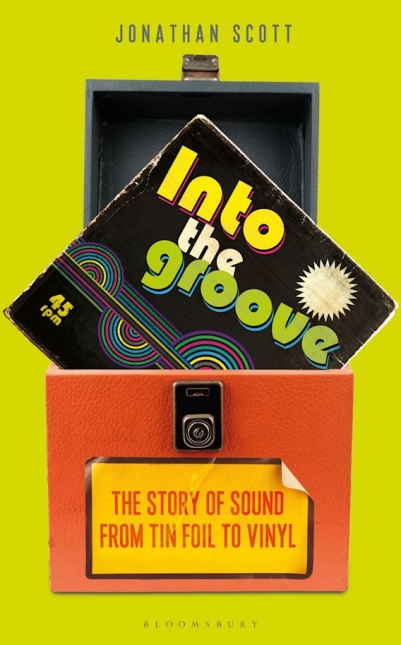Into the Groove: The Story of Sound from Tin Foil to Vinyl
- By Jonathan Scott
- Bloomsbury Sigma
- 320 pp.
- Reviewed by Eugene L. Meyer
- May 31, 2023
How did those vibrations get so good?

Now hear this! Those of a certain age may remember the term “groovy.” Boomers might think of Simon and Garfunkel’s 1968 hit “The 59th Street Bridge Song (Feelin’ Groovy).” Others may fondly recall being “in the groove.” Well, the groove of both the song and the expression refers to the furrow in disc records in which a needle moves laterally or (long ago) up and down to create sound.
Now comes Into the Groove: The Story of Sound from Tin Foil to Vinyl, a thoroughly entertaining history of how sound recordings evolved from (two- and then four-minute) cylinders to flat-disc shellac records to vinyl LP (long-playing) albums to 45 rpm (revolutions per minute) singles to eight-track and cassette tapes to CDs and now to MP3 digital streaming.
This is a book about the evolution of technology that manages to tell the story in accessible language — in other words, a technology book that’s not too technical. The tone is light and the narrative engaging. “You know you haven’t stopped talking since I came here?” begins a chapter heading from Groucho Marx. “You must have been vaccinated with a phonograph needle.”
Thomas Edison is, of course, given credit for inventing the first “talking machine,” but he mostly shelved it for years, focusing on electricity and the light bulb while others improved and capitalized on his audio creation. Emile Berliner, a German immigrant, first produced the flat discs that proved most popular for listening to, even as Edison stubbornly continued to manufacture cylinder records into the late 1920s.
Readers may be surprised to learn that the first recording of a phone call occurred in 1878. That same year, Edison foresaw “phonographic books that will speak to blind people without effort on their part.” (In a word, audiobooks!) Or that the first recorded swear word (f--k) was etched on an experimental glass disc in 1884.
Amid all the technical stuff, this reader, along with author Jonathan Scott, was struck by the wonder of it all and by the realization that much more — advances we now take for granted — was soon to come and was even predicted.
“Friends at a distance will then send to each other phonograph letters,” James Baird McClure wrote presciently in 1879. “How startling also it will be to reproduce and hear at pleasure the voice of the dead! All of these things are to be common, everyday experiences within a few years.”
Scott is an Englishman who ably covers both sides of the pond here. Within these pages is a lot of humour (humor, if you prefer) and a few marquee names Brits take for granted, including Penelope Keith, an English actress best known for her roles in BBC sitcoms, and Chris Sievey (aka Frank Sidebottom), a British musician and comedian.
Such cultural icons aside, Scott also memorializes the names of many formerly unsung technicians and others who worked to improve the reproduction of sound over the decades. (Today, they’d be called creatives and would have countless followers on social media.) Thus, we are introduced to people like Valdemar Poulsen, “the father of magnetic recording,” who, at the 1900 Paris World’s Fair, captured the voice of Emperor Franz Josef I of Austria.
Another we meet is Ralph Peer, who recorded country music in and around Bristol, Tennessee, in 1927. Those he recorded — among them Jimmie Rodgers and the Carter Family — are remembered. But who remembers Peer? Another forgotten name is graphic designer Alex Steinweiss; born in Brooklyn in 1917, he worked in relative obscurity but went on to design the first album cover, in 1940, for a Rodgers and Hart collection.
Remarkably, and to the author’s delight, despite the ever-evolving formats for recorded music, vinyl “keeps getting back up.” I read recently that the original 1959 vinyl record of Miles Davis’ “Kind of Blue” could be worth thousands now. As for current top artists, everyone from Beyoncé and Taylor Swift to Harry Styles releases brand-new albums on old-school vinyl.
After 265 pages of text, Scott shares an epiphany: “It wasn’t the format that was important, it wasn’t how you listened to anything. It was what you were listening to, and how what you listened to made you feel.” To bring us full circle in his excellent, absorbing book, he adds, “And it all came from the groove.”
Eugene L. Meyer, a member of the board of the Independent, is a journalist and author of, among other books, Five for Freedom: The African American Soldiers in John Brown’s Army and Hidden Maryland: In Search of America in Miniature. Meyer has been featured in the Biographers International Organization’s podcast series.

